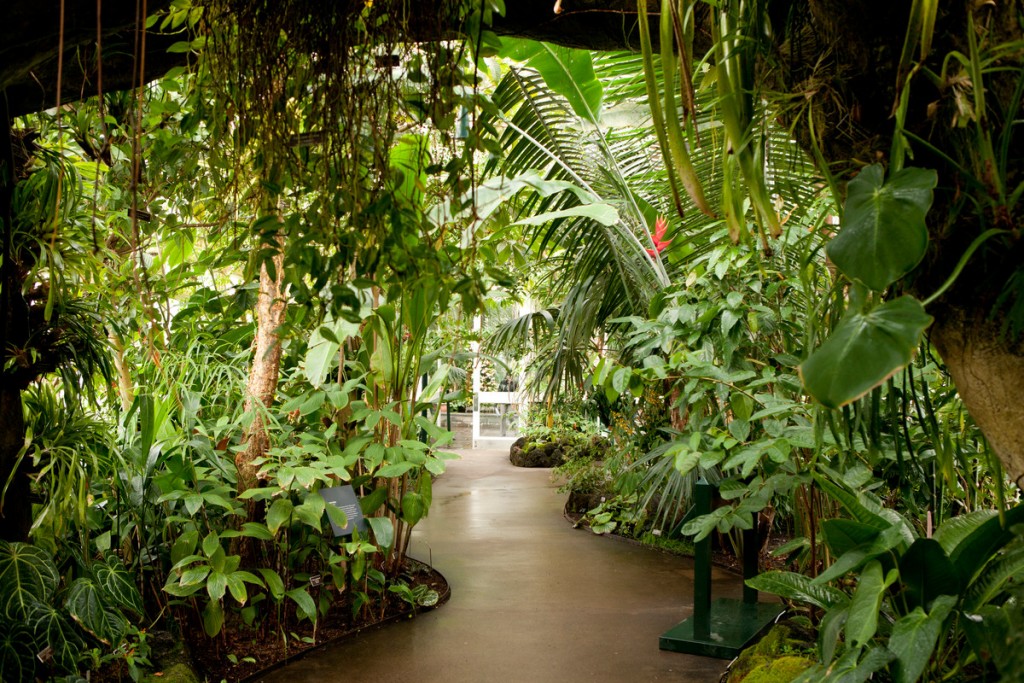Full STEAM Ahead: Students Build with Botany at GreenSchool
Posted in Around the Garden on February 1 2016, by Toni Ann Simone
Toni Ann Simone is a GreenSchool Science Education Intern at The New York Botanical Garden.

Holiday Train Show
Waves of students pool together inside the queues of the Enid A. Haupt Conservatory as they eagerly wait to explore its many biomes and exhibitions. A cluster at the front of the line indicates the children are balancing precariously on tip-toes to glance at the imposing structure placed near the entrance of the building. While some eyes light with recognition of the word “Macy’s” labeled on the brown, box-like creation, others are entranced by the toy train which circles it in an infinite loop. This grand replica of Manhattan’s famous department store, festively decorated with sprouting horns of white branches and red yuletide ornaments, stands as the captivating introduction to The New York Botanical Garden’s annual Holiday Train Show.
As GreenSchool’s intern for the 2015–2016 academic year, I am able to interact with these students and discuss what they observed as they participate in the GreenSchool’s plant science workshop, “Building with Botany.” Just like the Holiday Train Show which was restructured and expanded this year, so was its complementary workshop. “Building with Botany” is now a fully involved STEAM program; like its acronym, it seamlessly integrates science, technology, engineering, art, and mathematics.
I walk over to greet the school group and introduce myself. Then, I ask a very important question: “Why might a botanical garden, rather than an art museum, host an exhibition where all of these buildings are made out of natural materials?”
A boy timidly raises his hand. “Because it has plants?”
“Absolutely!” I respond. “Botanists, or plant scientists, work really hard to find just the right plant parts to create these buildings with. But, do you think these scientists had any help with setting up the Holiday Train Show?” Heads are uncertain as they nod around me and quiet answers are whispered under their breaths. “Do you think they received any help from artists?” Suddenly, the group comes alive as nods become more vigorous and tiny voices yelp thoughts aloud.
“The colors!”
“All of the decorations!”
“How the plants look next to each other!”
I smile and usher them silent. “You are showing careful attention to detail and you are all very right. Now, I want to take you to another area of this Conservatory where we are going to talk about artists and scientists a little bit more.”

Inside a humid rainforest or a desert speckled with spiny cactus, students are asked to make observations as to what an artist might notice about the particular biome while comparing that thought to what a botanist may notice. Sparks of understanding flash as students begin to realize there are specific scientific and artistic choices being made in each room within the conservatory, and that close observation of nature is an important skill of both plant scientists and artists.
The students are challenged to look even closer with a biome activity: each student is handed writing materials, along with boards labeled with a descriptive word. The objective of this activity is to find a plant to draw and write about that most reminds the student of the word on their board, a goal which may be easier said than done! Some words are simple, like “rough” and “slick.” Others require students to gaze even closer, looking for a plant that fits the word “symmetry” or “contrast.” By the end, students have successfully studied a variety of plant parts as they inspected shapes, colors, and textures from different angles.
In the GreenSchool classrooms, tables are set up with trays, glue, and an impressive array of plant materials similar to those used in the Holiday Train Show. Each of these plant parts, as the educator explains, plays a significant role in supporting plant life. Some of the plants, such as chamomile and beans, are edible and thus support human life, as well. After discussing these scientific functions of plant parts, the students are guided to explore how they might use those very same plant parts to create their own piece of art.

This intersection of disciplines is a significant learning opportunity. Often, in schools, students are faced with stringent lines which separate the arts and sciences. Art is art, and science is science—and there seems to be a limited cross-disciplinary bridge between the two subjects. However, through GreenSchool’s “Building with Botany” workshop, students are challenged to observe the Holiday Train Show and the diverse biomes within the Conservatory to look closely for that bridge themselves.
At the end of the day, when the school groups line up in front of the Conservatory to leave after the workshop, one can notice that something is different about them. Maybe it’s how their eyes no longer linger on the toy train whizzing around that brown, box-like structure of a Macy’s department store they saw earlier that morning. Perhaps, instead, it’s the way they nudge each other to notice the stems, bark, and other plant parts used to create a spectacular marvel of beautiful engineering.

